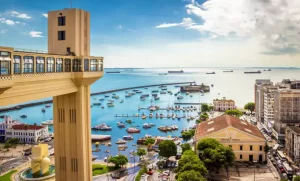Salvador da Bahia, often called simply Salvador, is a city of vibrant culture, historical charm, and coastal beauty. Known as the birthplace of Afro-Brazilian culture, Salvador offers a unique blend of music, dance, cuisine, and architecture, making it a must-visit destination in Brazil.
Essential Information
- Language: Portuguese
- Currency: Brazilian Real (BRL)
- Time Zone: Brasília Time (GMT-3)
- Climate: Tropical, with warm temperatures year-round (25-30°C or 77-86°F). Rainy season runs from April to June.
- Best Time to Visit: November to February for dry weather and the city’s famous Carnival festivities.
- International Airport: Deputado Luís Eduardo Magalhães International Airport (SSA).
Interesting Facts About Salvador
- Salvador was Brazil’s first capital, founded in 1549, and remains a hub of colonial history.
- It is the heart of Afro-Brazilian culture, heavily influenced by the African diaspora.
- The city’s Carnival is one of the largest and most energetic in the world.
- Salvador is home to capoeira, a martial art blending dance, acrobatics, and music.
How to Get There
- By Air: Direct flights connect Salvador with major Brazilian cities and international destinations such as Miami, Lisbon, and Buenos Aires.
- By Road: Salvador is accessible via highways BR-324 and BR-101. Long-distance buses are available.
- By Sea: Ferries connect Salvador to nearby islands like Itaparica and Morro de São Paulo.
Best Things to Do in Salvador
- Explore Pelourinho: A UNESCO World Heritage Site, this colorful historic district is packed with colonial buildings, churches, and museums.
- Visit Elevador Lacerda: This iconic elevator connects the Upper and Lower Cities, offering stunning views of the Bay of All Saints.
- Relax on Porto da Barra Beach: A favorite among locals for its calm waters and vibrant atmosphere.
- Experience Salvador’s Carnival: Join the electrifying street parties and parades during the world-famous event.
- Tour the Mercado Modelo: Shop for handicrafts and souvenirs in this bustling market.
- Admire the Church of São Francisco: Renowned for its Baroque architecture and gold-covered interior.
- Enjoy a Sunset at Farol da Barra: Visit the Barra Lighthouse for breathtaking ocean views.
Best Accommodation Options
- Luxury:
- Fera Palace Hotel: A stylish hotel in Pelourinho blending history and modern elegance.
- Hotel Fasano Salvador: An upscale choice with exceptional service and Bay of All Saints views.
- Mid-Range:
- Pousada Colonial: A charming colonial-style inn in the historic center.
- Bahia Othon Palace: Beachfront property offering great amenities at reasonable prices.
- Budget:
- Hostel Galeria 13: A vibrant hostel in Pelourinho, perfect for backpackers.
- Pousada do Pilar: Affordable with panoramic views of the bay.
Cultural and Modern Attractions
- Cultural:
- Museu Afro-Brasileiro: Learn about Afro-Brazilian history and culture.
- Casa do Carnaval da Bahia: Dive into Salvador’s rich Carnival traditions.
- Fundação Casa de Jorge Amado: A museum dedicated to the renowned Brazilian author.
- Modern:
- Shopping Barra: A contemporary mall with shopping, dining, and entertainment options.
- Dique do Tororó: A scenic lake featuring orixá statues representing Afro-Brazilian deities.
Dining and Nightlife
- Dining:
- Restaurante Senac Pelourinho: Sample traditional Bahian cuisine like moqueca and acarajé.
- Casa de Tereza: A celebrated spot blending modern and traditional flavors.
- Amado: Waterfront fine dining with innovative dishes.
- Nightlife:
- Santo Antônio Além do Carmo: A neighborhood known for its trendy bars and live music.
- Rio Vermelho: Salvador’s nightlife hub, offering everything from samba clubs to chic lounges.
- Pelourinho: Experience traditional music styles like samba de roda in lively squares.
Day Trips from Salvador
- Morro de São Paulo: A stunning island escape with beaches, nightlife, and eco-tourism activities.
- Praia do Forte: Visit the Tamar Project to see sea turtles and enjoy pristine beaches.
- Itaparica Island: Known for its relaxing beaches and quaint villages.
- Cachoeira: A colonial town in the Reconcavo region, steeped in Afro-Brazilian history.
Getting Around
- Public Transport: Buses are common but can be slow and crowded.
- Taxis and Ride-Sharing: Uber and 99 are widely available and convenient.
- Walking: Many attractions in Pelourinho and Barra are easily walkable.
- Ferries: Use ferries for access to nearby islands.
- Car Rentals: Ideal for exploring beyond the city.
Practical Tips
- Safety: Stay alert, especially in crowded areas, and avoid deserted streets at night.
- Health: Protect yourself from the sun and use insect repellent.
- Packing: Lightweight clothing, swimwear, and comfortable shoes are essential.
- Local Customs: Bahian culture is warm and welcoming—greet people with a smile and be open to trying local traditions.
Conclusion
Salvador da Bahia is a vibrant fusion of history, culture, and natural beauty. Whether you’re wandering through the cobblestone streets of Pelourinho, savoring Bahian delicacies, or dancing to the rhythms of samba and axé, Salvador promises an unforgettable experience. Plan your journey to this enchanting city, and immerse yourself in the heart of Brazil’s cultural heritage.

